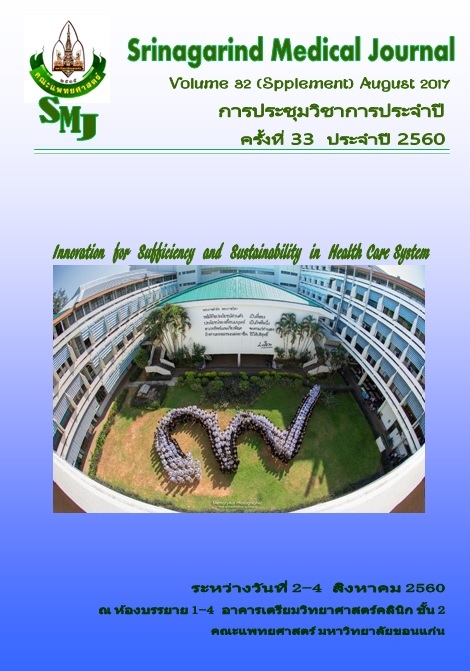เปรียบเทียบประสิทธิภาพของการระงับความรู้สึกบริเวณชายโครง และการให้ยาแก้ปวดไดโคลฟีแนค (cliclofenac) ในการลดอาการปวดแผลหลังผ่าตัดมะเร็งเต้านมในโรงพยาบาลศรีนครินทร์
Keywords:
Brest cancer, Postoperative pain in breast surgery, paravertebral block in modified radical mastectomy, paravertebral block in breast surgery, NSAIDs in breast surgeryAbstract
Background and objective: Breast cancer is the most common cancer and has the highest incidence rates in women worldwide. Modified Radical Mastectomy (MRM) is the commonly used surgical procedure for operable breast cancer. There are many choices of anesthetic techniques for breast surgery including Local infiltration, Regional anesthesia such as Intercostal nerve block, Thoracic epidural, Thoracic paravertebral block (PVB), General anesthesia. Breast surgery is often associated with postoperative pain, nausea, vomiting, chronic pain and painful restrict movement. Thoracic paravertebral block (TPVB)--Popular, especially as an anesthetic adjunct for breast surgery, ipsilateral somatic and sympathetic nerve blockade in multiple thoracic dermatomes, technically easy to learn with high success rate and low rate of serious complication, inhibit surgical stress and attenuate perioperative factors that enhance tumor growth and spread. Benefits of PVB include a reduction in postoperative nausea and vomiting (PONV), prolonged postoperative pain relief, prevent chronic pain, potential for ambulatory discharge, risk of recurrence or metastasis in patients undergoing radical mastectomy
Methods : This prospective descriptive study was done in 44 patients scheduled for elective mastectomy or modified radical mastectomy(MRM) at operating room, Srinagarind hospital. Patient were devided into 2 groups, Group PG (PVB with GA) and group NG (Diclofenac with GA). Patients were premedicated with fentanyl 1-2 mcg/kg IV, induction with propofol 1.5-2 mg/kg IV, intubation with cisatracurium 0.2 mg/kg IV, maintenance with air and oxygen Fio2 0.5 and sevoflurane. At 30 minutes before the end of operation, all patients received on dansetron 8 mg for prevent PONV. At the end of surgery, all patients were reversed from muscle relaxant with IV neostigmine 2.5 mg and IV atropine 1.2 mg.Then we connected IV PCA (Morphine 30 mg + NSS up to 30 ml) to all patients. Postoperatively, all patients were monitored in the recovery room for 1 hr -- If pain score > 5 give morphine 2-3 mg IV bolus and then repeat every 5 min for 3 times by blinded anesthetic team,patients were assess for pain at PACU after surgery then 1,6, 12, 24 and 48 h using NRS score of 0-10,postoperative at 24 and 48 h, the data of opioid comsumption were collected. Complication of PVB and NSAIDs were assessed at 24 hrs postoperatively include pneumothorax, PONV, nerve injury,high block, total block,dyspepsia
Results : There were statistically highly significant decreases in intraoperative and postoperative morphine consumption in the NG group than the PG group. There were statistically significant decreases in the NRS in the NG group than the PG group both at rest and with shoulder movement. The incidence of adverse events was very low in both groups.
Conclusion : Intraveneous diclofenac provides effective pain relief, significant opioid sparing, and also less painful restricted movement of the shoulder, with few side effects after breast cancer surgery. Intraveneous diclofenac may be an alternative to general anaesthesia for major unilateral breast surgery.




